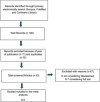Effectiveness and safety of polyethylene-glycol-4000 versus sodium picosulphate plus magnesium oxide and citric acid for bowel cleansing before colonoscopy in children: A systematic review with meta-analysis
- PMID: 39400405
- PMCID: PMC11717393
- DOI: 10.1002/jpn3.12388
Effectiveness and safety of polyethylene-glycol-4000 versus sodium picosulphate plus magnesium oxide and citric acid for bowel cleansing before colonoscopy in children: A systematic review with meta-analysis
Erratum in
-
Correction to "Effectiveness and safety of polyethylene-glycol-4000 versus sodium picosulphate plus magnesium oxide and citric acid for bowel cleansing before colonoscopy in children: A systematic review with meta-analysis".J Pediatr Gastroenterol Nutr. 2025 Oct 6. doi: 10.1002/jpn3.70220. Online ahead of print. J Pediatr Gastroenterol Nutr. 2025. PMID: 41053918 No abstract available.
Abstract
Colonoscopy is performed for diagnostic and therapeutic purposes. The quality of colonoscopy depends on adequate bowel cleansing. However, there is no standardized protocol for bowel preparation in children. We conducted a systematic review and meta-analysis of randomized controlled trials (RCTs) to estimate the effectiveness, safety, and tolerability profile of polyethylene glycol (PEG) compared with those of sodium picosulfate magnesium citrate (SPMC) in children. The primary sources of the reviewed studies were Scopus, PubMed, and Cochrane Library. The databases were systematically searched for RCTs comparing PEG 4000 to SPMC as a bowel cleansing solution. Six studies were included. The analysis showed that both PEG and SPMC are effective for bowel cleansing, while a split-dose regimen may be preferable to a day-before one. There were no differences between the two groups regarding adverse events (AEs) such as abdominal pain, nausea, vomiting, bloating, and anal discomfort. Additionally, preparation with SPMC was preferred in terms of acceptability and compliance. Still, the need to place a nasogastric tube was significantly lower in the SPMC group compared to the PEG group and in the split dose regimen compared to the day before. In conclusion, PEG and SPMC are equally effective in obtaining an adequate bowel cleansing with a comparable AE rate; moreover, split-dose administration may be preferable to day-before one in terms of effective bowel cleansing. However, SPMC preparation is more acceptable seems to result in higher compliance, and to reduce the use of a nasogastric tube, that we encounter daily in clinical practice, is perceived as a stressful experience for children and their families.
Keywords: bowel preparation; endoscopy; pediatric.
© 2024 The Author(s). Journal of Pediatric Gastroenterology and Nutrition published by Wiley Periodicals LLC on behalf of European Society for Pediatric Gastroenterology, Hepatology, and Nutrition and North American Society for Pediatric Gastroenterology, Hepatology, and Nutrition.
Conflict of interest statement
The authors declare no conflict of interest.
Figures



References
-
- Rex DK, Schoenfeld PS, Cohen J, et al. Quality indicators for colonoscopy. Gastrointest Endosc. 2015;81(1):31‐53. - PubMed
-
- Lightdale JR, Acosta R, Shergill AK, et al. Modifications in endoscopic practice for pediatric patients. Gastrointest Endosc. 2014;79(5):699‐710. - PubMed
-
- Thomson M, Tringali A, Dumonceau JM, et al. Paediatric gastrointestinal endoscopy: European Society for Paediatric Gastroenterology Hepatology and Nutrition and European Society of Gastrointestinal Endoscopy Guidelines. J Pediatr Gastroenterol Nutr. 2017;64(1):133‐153. - PubMed
-
- Belsey J, Epstein O, Heresbach D. Systematic review: oral bowel preparation for colonoscopy. Aliment Pharmacol Ther. 2007;25(4):373‐384. - PubMed
Publication types
MeSH terms
Substances
Grants and funding
LinkOut - more resources
Full Text Sources
Medical

